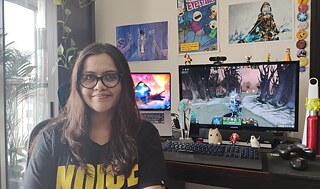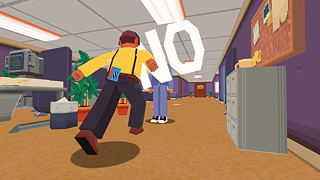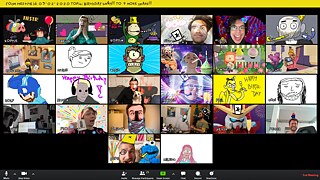Dizziness on a Fine Line
In the life of a Game Developer

Video games are challenging even during production. Poornima Seetharaman and Sebastian Hollstein can confirm this. They design very different games in Bengaluru and Berlin, yet face similar challenges.
By Jan Bojaryn
“I love working from home,” declares Poornima Seetharaman. Of course, she’s not happy about the reason; her employer’s office in Bengaluru is closed due to the coronavirus pandemic. Sebastian Hollstein is also at home. He usually works in the Berlin coworking space Saftladen.
Even without a pandemic, workdays in the games industry in Germany and India would have a lot in common: Both professionals have to balance meetings, admin and actual game development. Both have to battle to keep their day from getting too long.

Multi-tasking makes me dizzy."
Sebastian Hollstein
Blocked calendars
Seetharaman also has to stay on top of things. As lead game designer at Zynga, she’s responsible for a wide range of tasks. Although it’s important to her to “pitch-in” herself and help design the actual game, she has to set the direction, control the progress of the teams involved, keep an eye out for problems and guide employees. Not only are lots of meetings needed for all of this to work, but also periods of guaranteed quiet time. “Sometimes I block my online calendar so I can concentrate on a task,” she says.

More money for art
The medium itself is important for Seetharaman. She describes herself as a person with an “indie attitude” – she loves games that have cultural aspirations and a message like the platform adventure Gris by the Spanish indie developer Nomada Studio. She herself “experimented” for a year on her own account before taking up the post at Zynga. She develops her own ideas; but when she told her contacts years ago about her idea for a biographically inspired game about Carnatic music, they were skeptical. “Who would play that?” she was asked.If you want to make creative games in India, you need to aim at the global market."
Poornima Seetharaman
Game financing in India is getting better, but “we need more money for indies,” Seetharaman sums up the problem. Art projects also have to assert themselves according to commercial criteria.
Things aren’t easy for Hollstein in Germany, but it’s precisely with this approach of creative self-realization that he’s been successful. “We wouldn’t mind becoming millionaires,” he grins, “but that’s not why we founded the studio.” In fact, his studio’s games have also enjoyed financial success, but “we always count on zero euros” profit. In the meantime, state, federal and EU funding help with the financing. Publishers also contribute a large part of the money. Hollstein has to convince the sponsors of his games; he has to justify growing budgets. That too requires a balance. “Of course, we want to earn money with our games but without throwing our attitude and complexity overboard,” says Hollstein. “We’re not bowing to the market.”

A generation too soon
Seetharaman is still dissatisfied with the perception of her medium at home. In public perception, games are still either casual fluff like Candy Crush Saga or shooting games like PlayerUnknown’s Battlegrounds. The poles range from addiction to a waste of time. She would like to see more interest in and openness to the beauty of the medium, especially from parents – she enjoys talking shop with her eight-year-old nephew on the phone about Minecraft.The time has come for indies."
Poornima Seetharaman
In a way, Hollstein has it easier: Politically, video games are accepted as a cultural asset. Angela Merkel’s visit to the opening of Gamescom is considered a milestone of recognition. “There’s a lot going on in Germany,” he acknowledges. But he also sees part of the problem in the games themselves: Even the typical gamepads are a closed book for non-gamers. And if you didn’t start at 13, you’ll hardly make it through a 3D game today. Hollstein is bothered by the barriers that games build around the medium.
He, too, knows parents who can’t really talk about games with their kids. Before Minecraft anecdotes at the dinner table become the norm, “it might take another generation,” he estimates soberly. Seetharaman sees things the same way.
The medium is international; so are its problems.
DID you know?
Poornima Seetharaman is the first Indian to be inducted in the Women in Games (WIGJ) Hall of Fame.